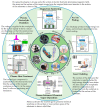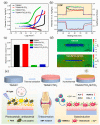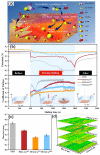Tribocorrosion and Surface Protection Technology of Titanium Alloys: A Review
- PMID: 38203919
- PMCID: PMC10779822
- DOI: 10.3390/ma17010065
Tribocorrosion and Surface Protection Technology of Titanium Alloys: A Review
Abstract
Titanium alloy has the advantages of high specific strength, good corrosion resistance, and biocompatibility and is widely used in marine equipment, biomedicine, aerospace, and other fields. However, the application of titanium alloy in special working conditions shows some shortcomings, such as low hardness and poor wear resistance, which seriously affect the long life and safe and reliable service of the structural parts. Tribocorrosion has been one of the research hotspots in the field of tribology in recent years, and it is one of the essential factors affecting the application of passivated metal in corrosive environments. In this work, the characteristics of the marine and human environments and their critical tribological problems are analyzed, and the research connotation of tribocorrosion of titanium alloy is expounded. The research status of surface protection technology for titanium alloy in marine and biological environments is reviewed, and the development direction and trends in surface engineering of titanium alloy are prospected.
Keywords: marine; plasma surface engineering; titanium alloys; tribocorrosion.
Conflict of interest statement
The authors declare no conflict of interest.
Figures


















Similar articles
-
Tribocorrosion-Resistant Ti40Nb-TiN Composites Having TiO2-Based Nanotubular Surfaces.ACS Biomater Sci Eng. 2022 May 9;8(5):1816-1828. doi: 10.1021/acsbiomaterials.1c01446. Epub 2022 Apr 22. ACS Biomater Sci Eng. 2022. PMID: 35452579
-
Tribocorrosion studies of metallic biomaterials: The effect of plasma nitriding and DLC surface modifications.J Mech Behav Biomed Mater. 2016 Oct;63:100-114. doi: 10.1016/j.jmbbm.2016.06.014. Epub 2016 Jun 17. J Mech Behav Biomed Mater. 2016. PMID: 27348147
-
Determining Tribocorrosion Rate and Wear-Corrosion Synergy of Bulk and Thin Film Aluminum Alloys.J Vis Exp. 2018 Sep 11;(139):58235. doi: 10.3791/58235. J Vis Exp. 2018. PMID: 30272652 Free PMC article.
-
Surface Texture-Based Surface Treatments on Ti6Al4V Titanium Alloys for Tribological and Biological Applications: A Mini Review.Materials (Basel). 2018 Mar 24;11(4):487. doi: 10.3390/ma11040487. Materials (Basel). 2018. PMID: 29587358 Free PMC article. Review.
-
A review on wear, corrosion, and wear-corrosion synergy of high entropy alloys.Heliyon. 2024 Feb 11;10(4):e25867. doi: 10.1016/j.heliyon.2024.e25867. eCollection 2024 Feb 29. Heliyon. 2024. PMID: 38384552 Free PMC article. Review.
Cited by
-
Metal implants in children.J Child Orthop. 2024 Nov 7;18(6):557-568. doi: 10.1177/18632521241293954. eCollection 2024 Dec. J Child Orthop. 2024. PMID: 39539480 Free PMC article. Review.
-
Microstructure and Wear Behavior of WMoTaNbV Refractory High-Entropy Alloy Coating on Ti6Al4V Alloy Surface Prepared by Laser Cladding.Materials (Basel). 2025 Apr 12;18(8):1770. doi: 10.3390/ma18081770. Materials (Basel). 2025. PMID: 40333378 Free PMC article.
-
Enhanced biological performance of Sr2+-doped nanorods on titanium implants by surface thermal-chemical treatment.J Mater Sci Mater Med. 2025 Jun 23;36(1):54. doi: 10.1007/s10856-025-06898-z. J Mater Sci Mater Med. 2025. PMID: 40549257 Free PMC article.
References
-
- Muthaiah V.M.S., Indrakumar S., Suwas S., Chatterjee K. Surface engineering of additively manufactured titanium alloys for enhanced clinical performance of biomedical implants: A review of recent developments. Bioprinting. 2022;25:e00180. doi: 10.1016/j.bprint.2021.e00180. - DOI
-
- Gao A., Hang R., Bai L., Tang B., Chu P.K. Electrochemical surface engineering of titanium-based alloys for biomedical application. Electrochim. Acta. 2018;271:699–718. doi: 10.1016/j.electacta.2018.03.180. - DOI
-
- Gupta M.K., Etri H.E., Korkmaz M.E., Ross N.S., Krolczyk G.M., Gawlik J., Yaşar N., Pimenov D.Y. Tribological and surface morphological characteristics of titanium alloys: A review. Arch. Civ. Mech. Eng. 2022;22:72. doi: 10.1007/s43452-022-00392-x. - DOI
-
- Li G., Chandra S., Rahman Rashid R.A., Palanisamy S., Ding S. Machinability of additively manufactured titanium alloys: A comprehensive review. J. Manuf. Process. 2022;75:72–99. doi: 10.1016/j.jmapro.2022.01.007. - DOI
Publication types
Grants and funding
LinkOut - more resources
Full Text Sources

